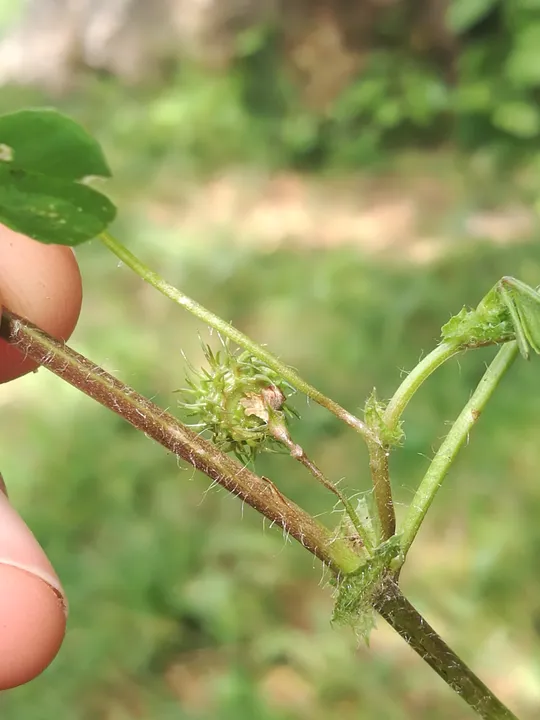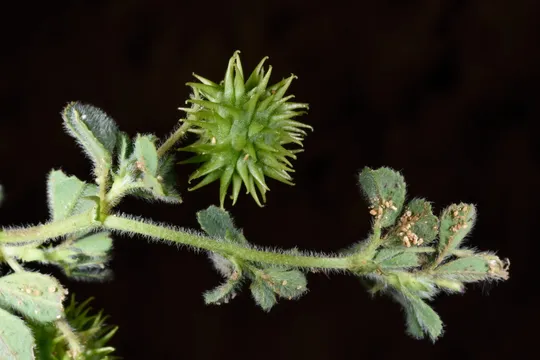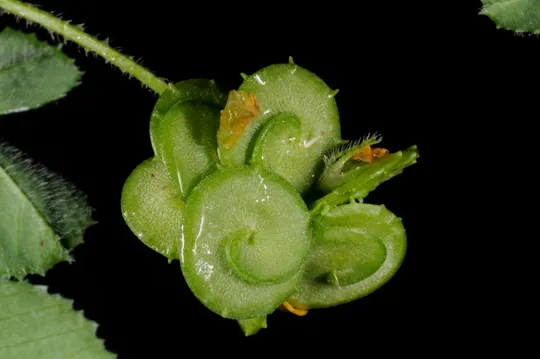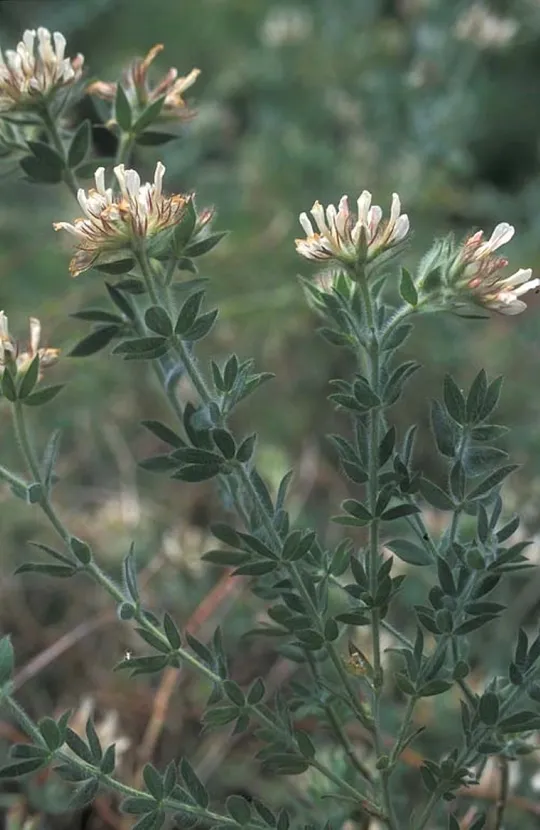Spiny Medick, Murex Medic
Medicago murex
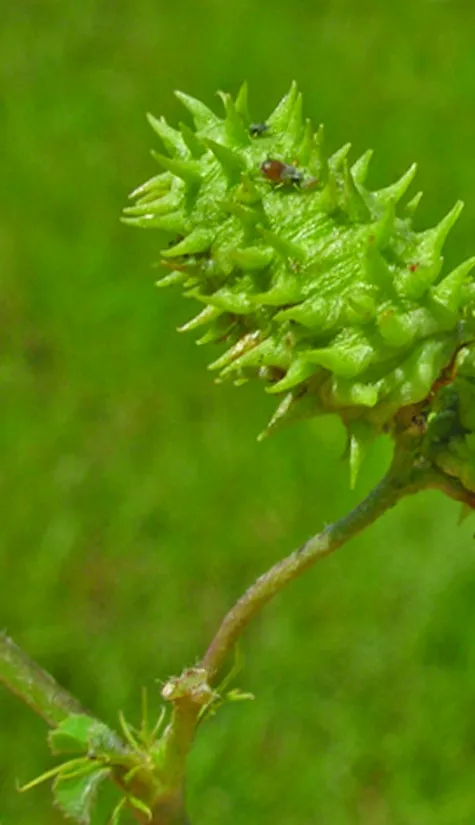
Medicago murex is an annual prostrate plant, 20-30 cm across and 5-10 cm tall. It has trifoliate leaves and leaflets shaped like inverted spikes, serrated at the top. The stipules are thin, connected to the petioles, and have long teeth.
Medicago murex grows in areas of the Sharon and the Philistean Plain as
well as at the foot of Mount Hermon. In the Sharon the species is known
from a number of sites: Caesarea, Ahu Binyamina Nature Reserve, the
Hadera Forest, the Dora Pond Nature Reserve, Hod HaSharon, and the dunes
west of Pardes Hanna. In the Philistean Plain, it is very rare, and has
been collected in recent years only near Netser-Sereni. At the food of
Mount Hermon it has been seen on Nubian sandstone on Mt. Keta. Random
single collections were recorded from mountainous areas – the Upper
Galilee (Kibbutz Yiftah), the Judean Mountains, the Judean Desert (Shekh
Anbar = the Zuher neighborhood on the way to Ma'ale Adumim). This is a
very rare species that usually grows as a singleton (represented by a
single individual).
Medicago murex grows in sandy soils, in sand fields along with Retama and Artemisia, and in hamra-sand with Desmostachya bipinnata. In the isolated mountain sites in which it is found it grows on calcareous rock and soil with no connection to a sandy substrate. At those sites, it grows on roadsides and in sunny scrublands in the Mediterranean region.
Medicago murex is an annual species. It is very hard to identify it and it is very rare throughout Israel. There are two varieties in the country: one grows in the dunes (var. murex); and the second, some of whose fruits lack bristles, is more common in mountainous areas of the Mediterranean region (var. inermis). The latter subspecies is considered an invasive species in Europe and grows on roadsides and fallow fields.
M. murex has fruit shaped similarly to the fruit of two additional Medicago species that grow in Israel, Medicago constricta and Medicago tuberculata. In all of these species, the spires of the fruit are tightly coiled, the fruit is rounded on top (the spires get smaller towards the top of the fruit) and the bristles are short, hooked, and thick at their base. Medicago doliata is common in the Upper Galilee, Mount Meron and Golan Heights regions, where it grows in moist woodland; both its leaves and fruit are covered in hair. Medicago constricta also has leaves that are hairy on both sides, but its fruit is almost completely smooth; it grows on dry sunny slopes, and usually grows individually (singleton). It is relatively common in the mountainous zone on the Hermon. Flora Palaestina notes it as a plant that grows in sandy soil. The young leaves in M. murex are hairy and become smooth as they mature. The venous pattern on the spire, found only on its inside is unique to the species (an important, but difficult to distinguish feature).
Because of the difficulty in distinguishing between the different Medicago species, there is some confusion regarding its rarity, and the extinction rate of the species mentioned above. This is particularly true of M. constricta, which has consequently not been placed on the red list.
• The number of sites where Medicago murex grows is decreasing due to loss of sandy habitats in the Sharon and the Philistean Plain.
• Population densities of M. murex are low, and it does not form large populations, which greatly increases its rarity and threatens its existence in case of habitat loss.
• Its global range is expanding, and it is probably not globally endangered.
Medicago murex sites should be identified in the Dora Pond and Ahu Binyamina areas, where it should be closely monitored. It is simple and possible to populate new locations which include extensive areas of its habitat, and to conduct strict demographic monitoring in these locations.
Medicago murex has a typical Mediterranean distribution: it grows in all the countries bordering the Mediterranean Sea except for Egypt – from Spain in the west, through Italy and Sicily, down to Turkey and Syria-Lebanon in the east. Its range does not continue further east, but M. murex may be found in Central Europe and the Atlantic coast as a ruderal plant.
Medicago murex is an annual species that grows in the coastal plain in sandy soil. Most of its habitat sites have been destroyed over the past eighty years, and it remains only in a small number of sites where it grows in low densities, mostly as scattered individuals.
Heyn, C.C.1963 The annual species of Medicago. Scr. Herosolymthana, 12:1–154.
Current Occupancy Map
| 1000 squre meter pixel | 5000 squre meter pixel | 10000 squre meter pixel | |
|---|---|---|---|
| number of observations | 0 | 0 | 0 |
| in total pixels | 0 | 0 | 0 |
| Family | Fabaceae |
| Classification | On the endangered species list |
| Ecosystem | Coastal area |
| Chorotype | Mediterranean and Euro – Siberian |
| Conservation Site | Dora Pond |
| Rarity |
1
3
6
|
|---|---|
| Vulnerability |
0
4
4
|
| Attractiveness |
0
0
4
|
| Endemism |
0
0
4
|
| Red number |
1
4.2
10
|
| Peripherality | N |
| IUCN category | DD EW EX LC CR EN VU NT |
| Threat Definition according to the red book | Endangered |
 Based on:
Based on:
